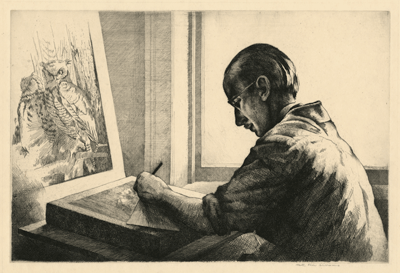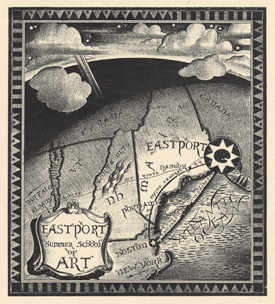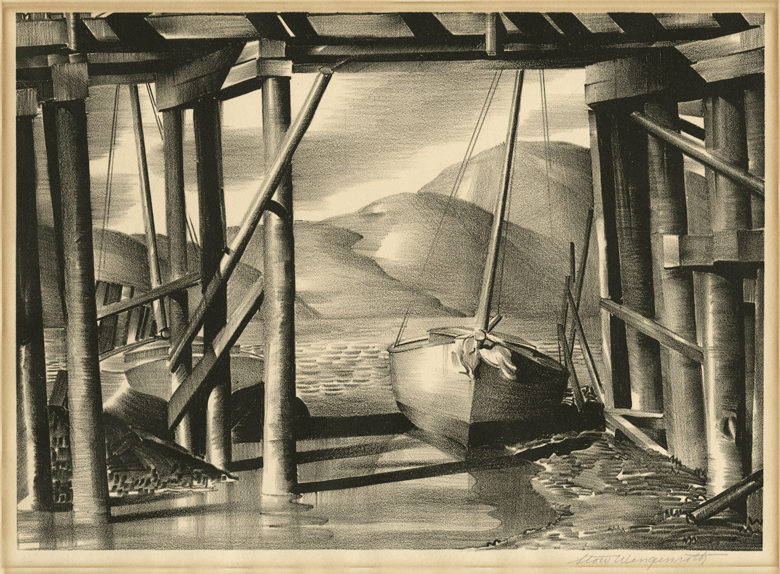In 1927, the Grand Central Art School started offering summer classes in Eastport. Founded in 1923 by painters John Singer Sargent, Walter Leighton Clark, and Edmund Greacan, the esteemed school located in New York City’s Grand Central Terminal decided to establish a chapter way Downeast.

Artist George Pearse Ennis (1884-1936), who taught at the Grand Central Art School and knew Eastport from a previous visit, took the lead. On the cover of the 1928 brochure for the Eastport Summer Art School, Ennis offered an inventory of the town’s subject matter.
“There are bold headlands, rugged coves, scores of islands—wooded, rocky; there is the odd charm of the lobster fisherman—the picturesque life of the sardine fleet; there are wharves and sheds and harbor-life—a varied waterfront of intensely appealing material, and an old rambling town of interesting streets and homes.”
The description of this picturesque setting worked. By the time Stow Wengenroth (1906-1978) joined the faculty in 1932, the school was flourishing. Classes took place in the former Boynton High School building, which the town renovated.
At age 26, the Brooklyn, New York-born Wengenroth was already an accomplished lithographer. He took full advantage of the motifs Ennis identified, creating his first major series of prints. His headlands were bold, his coves rugged, and his waterfronts worked.
“Low Tide” exemplifies Wengenroth’s extraordinary ability to render light and dark, not to mention the curve of boat hulls and the lean of a wharf. The unusual setting—beneath a dock—adds to the distinct waterfront mood. There is so much to admire here, from the framed view of distant hills to the architecture of the pilings.
“‘Low Tide’ is Eastport,” notes Hugh French, director of the Tides Institute and Museum of Art in Eastport, “but it’s hard to tell exactly where.” French suggests it might be along the harbor with one of the nearby New Brunswick islands, such as Campobello, in the background.
“Wengenroth often exaggerated the height of island landscapes in his work of this time,” he writes.
Speaking of exaggeration, the 1932 brochure for the summer school featured Wengenroth’s wonderful map of Eastport in which he makes the city the star of the Northeast—not unlike Saul Steinberg’s famous New Yorker cover “View of the World from 9th Avenue” (1976). Among other details, look for the arcing line of the Maine Central Railroad.

From student testimonials, Wengenroth was a terrific teacher and mentor (see “Gregory Dunham paints Eaton’s Boatyard,” The Working Waterfront, November 2022). Boston artist Elizabeth Saltonstall (1900-1990) described him as “great fun,” remembering how he’d put on a poker face before he pulled the print. Thanks to his encouragement, she became a master lithographer in her own right.
The Eastport series led to further explorations of landscapes, primarily in Maine and Massachusetts, but also, notably, New York City (his nocturnes can compete with Hopper’s). Wengenroth’s images of Monhegan and various coastal subjects remain classics, as do his brilliant portrayals of owls, terns, and other birds. It’s no wonder Andrew Wyeth famously designated him “America’s greatest living artist working in black and white.”
The Eastport Summer School of Art eventually cut ties with the Grand Central School and became a separate entity, but it closed in 1936 when Ennis died in a car accident. Wengenroth would go on to write books and articles on printmaking and create many more luminous lithographs. And he never stopped frequenting waterfronts.
Carl Little thanks the Tides Institute and Museum of Art for providing invaluable background, including Margaret Whalen’s essay on the Eastport Summer School of Art. You can find these resources at www.tidesinstitute.org.
Carl Little curated “Avian Artistry: Treasures from Maine Collections” at the Wendell Gilley Museum (through August 17). The exhibition features a watercolor of a Baltimore oriole by Wengenroth.





